Analysis of Different Winding Configuration on Electromagnetic Performance of Novel Dual Three-Phase Outer-Rotor Flux-Switching Permanent Magnet Machine for Oscillating Water Column Wave Energy Generation
Abstract
1. Introduction
2. OR-FSPM Generator Topology and Winding Configuration
2.1. Topology
2.2. Winding Configuration
3. Electromagnetic Characteristic Analysis
3.1. PM Field Distribution and Air-Gap Flux Density
3.2. PM Flux Linkage, Back EMF and Rectified Voltage
3.3. Cogging Torque and Electromagnetic Torque
3.4. Inductance
3.5. Unbalanced Magnetic Force
4. Experimental Verification
5. Conclusions
Author Contributions
Funding
Data Availability Statement
Conflicts of Interest
References
- Rauch, S.E.; Johnson, L.J. Design Principles of Flux-Switching Alternators; IEEE: Piscataway, NJ, USA, 1955. [Google Scholar]
- Rauch, S.E.; Johnson, L.J. Design Principles of Flux-Switch Alternators. Trans. Am. Inst. Electr. Eng. Part III Power Appar. Syst. 1955, 74, 1261–1268. [Google Scholar] [CrossRef]
- Sanabria-Walter, C. Design of a 600kW Ring-Type Direct-Drive Flux-Switching Permanent Magnet Machine for Aerospace Main Propulsion. In Proceedings of the 2014 16th European Conference on Power Electronics and Applications, Lappeenranta, Finland, 26–28 August 2014; pp. 1–10. [Google Scholar]
- Hao, L.; Lin, M.; Zhao, X.; Fu, X.; Zhu, Z.Q.; Jin, P. Static Characteristics Analysis and Experimental Study of a Novel Axial Field Flux-Switching Permanent Magnet Generator. IEEE Trans. Magn. 2012, 48, 4212–4215. [Google Scholar] [CrossRef]
- Hua, W.; Zhang, G.; Cheng, M. Investigation and Design of a High-Power Flux-Switching Permanent Magnet Machine for Hybrid Electric Vehicles. IEEE Trans. Magn. 2015, 51, 8201805. [Google Scholar] [CrossRef]
- Cao, R.; Jin, Y.; Zhang, Z.; Cheng, M. A New Double-Sided Linear Flux-Switching Permanent Magnet Motor With Yokeless Mover for Electromagnetic Launch System. IEEE Trans. Energy Convers. 2019, 34, 680–690. [Google Scholar] [CrossRef]
- Huang, L.; Hu, M.; Liu, J.; Yu, H.; Zeng, C.; Chen, Z. Electromagnetic Design of a 10-kW-Class Flux-Switching Linear Superconducting Hybrid Excitation Generator for Wave Energy Conversion. IEEE Trans. Appl. Supercond. 2017, 27, 5201706. [Google Scholar] [CrossRef]
- Khatri, P.; Liu, Z.; Rudolph, J.; Wang, X. A Study of a Modified Design of Dumbbell-Shaped Flux Switching Tubular Linear Generator for Regular Wave Energy Conversion. Renew. Energy 2023, 208, 287–300. [Google Scholar] [CrossRef]
- Liu, Z.; McGregor, C.; Ding, S.; Wang, X. Study of a Three-Dimensional Model Simulation of a Speed Amplified Flux Switching Linear Generator for Wave Energy Conversion and Its Design Optimization in the Ocean Environment. Energy 2023, 284, 128625. [Google Scholar] [CrossRef]
- Sheng, W. Wave Energy Conversion and Hydrodynamics Modelling Technologies: A Review. Renew. Sustain. Energy Rev. 2019, 109, 482–498. [Google Scholar] [CrossRef]
- Delmonte, N.; Barater, D.; Giuliani, F.; Cova, P.; Buticchi, G. Review of Oscillating Water Column Converters. IEEE Trans. Ind. Appl. 2016, 52, 1698–1710. [Google Scholar] [CrossRef]
- M’zoughi, F.; Bouallègue, S.; Garrido, A.J.; Garrido, I.; Ayadi, M. Stalling-Free Control Strategies for Oscillating-Water-Column-Based Wave Power Generation Plants. IEEE Trans. Energy Convers. 2018, 33, 209–222. [Google Scholar] [CrossRef]
- Thomas, A.S.; Zhu, Z.Q.; Owen, R.L.; Jewell, G.W.; Howe, D. Multiphase Flux-Switching Permanent-Magnet Brushless Machine for Aerospace Application. IEEE Trans. Ind. Appl. 2009, 45, 1971–1981. [Google Scholar] [CrossRef]
- Li, F.; Hua, W.; Tong, M.; Zhao, G.; Cheng, M. Nine-Phase Flux-Switching Permanent Magnet Brushless Machine for Low-Speed and High-Torque Applications. IEEE Trans. Magn. 2015, 51, 8700204. [Google Scholar] [CrossRef]
- Shao, L.; Hua, W.; Zhu, Z.Q.; Tong, M.; Zhao, G.; Yin, F.; Wu, Z.; Cheng, M. Influence of Rotor-Pole Number on Electromagnetic Performance in 12-Phase Redundant Switched Flux Permanent Magnet Machines for Wind Power Generation. IEEE Trans. Ind. Appl. 2017, 53, 3305–3316. [Google Scholar] [CrossRef]
- Zhao, J.; Lu, Z.; Han, Q.; Wang, L.; Wang, L. Design and Analysis of a Novel Six-Phase Axial Switched-Flux Permanent Magnet Machine With Different Winding Configuration. IEEE Trans. Magn. 2023, 59, 8102306. [Google Scholar] [CrossRef]
- Fei, W.; Luk, P.C.K.; Shen, J.X.; Wang, Y.; Jin, M. A Novel Permanent-Magnet Flux Switching Machine With an Outer-Rotor Configuration for In-Wheel Light Traction Applications. IEEE Trans. Ind. Appl. 2012, 48, 1496–1506. [Google Scholar] [CrossRef]
- Hua, W.; Zhang, H.; Cheng, M.; Meng, J.; Hou, C. An Outer-Rotor Flux-Switching Permanent-Magnet-Machine with Wedge-Shaped Magnets for in-Wheel Light Traction. IEEE Trans. Ind. Electron. 2017, 64, 69–80. [Google Scholar] [CrossRef]
- Zhang, H.; Hua, W.; Zhang, G. Analysis of Back-EMF Waveform of a Novel Outer-Rotor-Permanent-Magnet Flux-Switching Machine. IEEE Trans. Magn. 2017, 53, 8105004. [Google Scholar] [CrossRef]
- Mo, L.; Zhang, T.; Lu, Q. Design and Analysis of an Outer-Rotor-Permanent-Magnet Flux-Switching Machine for Electric Vehicle Applications. IEEE Trans. Appl. Supercond. 2019, 29, 3601305. [Google Scholar] [CrossRef]
- Farahzadi, M.; Ali, S.; Mirnikjoo, S.; Abbaszadeh, K.; Marignetti, F.; Salehi, M. Design and Experimental Validation of a New Outer Rotor Double PM Excited Flux Switching Generator for Direct Drive Wind Turbines. IEEE Access 2024, 12, 62256–62267. [Google Scholar] [CrossRef]
- Chen, H.; Liu, X.; EL-Refaie, A.M.; Zhao, J.; Demerdash, N.A.O.; He, J. Comparative Study of Winding Configurations of a Five-Phase Flux-Switching PM Machine. IEEE Trans. Energy Convers. 2019, 34, 1792–1804. [Google Scholar] [CrossRef]
- Chen, H.; Liu, X.; Demerdash, N.A.O.; EL-Refaie, A.M.; Zhao, J.; He, J. Comparison and Design Optimization of a Five-Phase Flux-Switching PM Machine for In-Wheel Traction Applications. IEEE Trans. Energy Convers. 2019, 34, 1805–1817. [Google Scholar] [CrossRef]
- Shao, L.; Hua, W.; Zhu, Z.Q.; Huang, W.; Wu, Z.; Li, F.; Cheng, M. Investigation on Phase Shift Between Multiple Multiphase Windings in Flux-Switching Permanent Magnet Machines. IEEE Trans. Ind. Appl. 2017, 53, 1958–1970. [Google Scholar] [CrossRef]
- Chen, J.T.; Zhu, Z.Q. Winding Configurations and Optimal Stator and Rotor Pole Combination of Flux-Switching PM Brushless AC Machines. IEEE Trans. Energy Convers. 2010, 25, 293–302. [Google Scholar] [CrossRef]
- Wu, Z.Z.; Zhu, Z.Q. Analysis of Air-Gap Field Modulation and Magnetic Gearing Effects in Switched Flux Permanent Magnet Machines. IEEE Trans. Magn. 2015, 51, 8105012. [Google Scholar] [CrossRef]
- Zhang, H.; Hua, W.; Wu, Z.; Zhu, X. Design Considerations of Novel Modular-Spoke-Type Permanent Magnet Machines. IEEE Trans. Ind. Appl. 2018, 54, 4236–4245. [Google Scholar] [CrossRef]
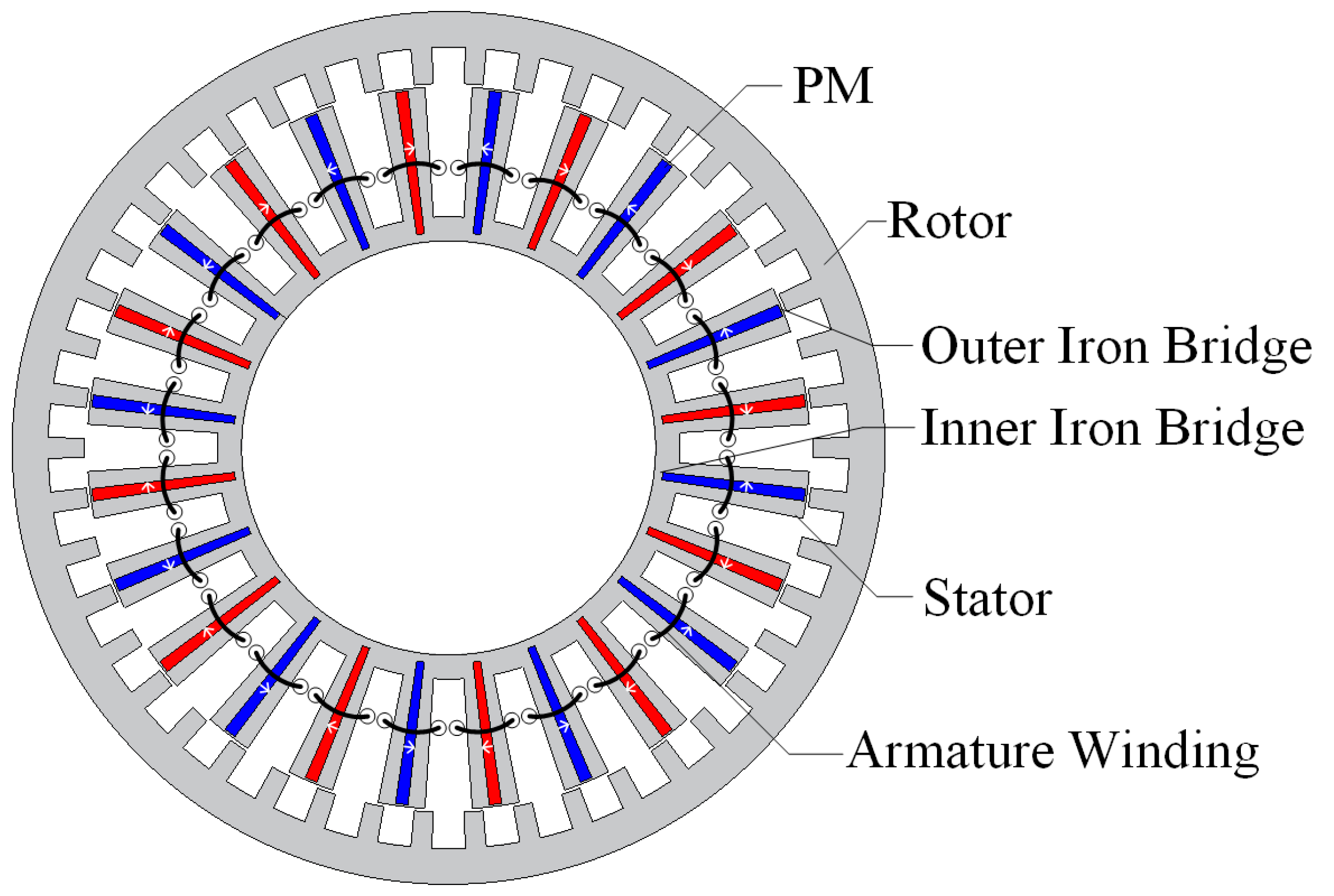
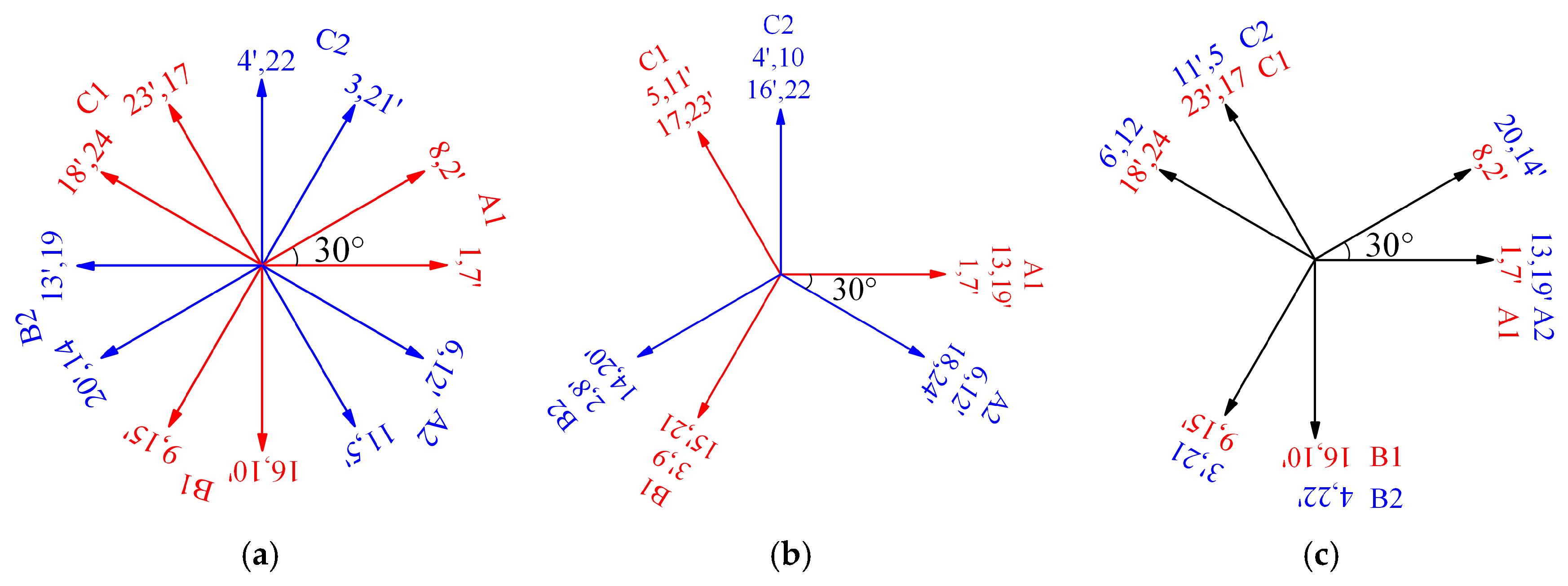
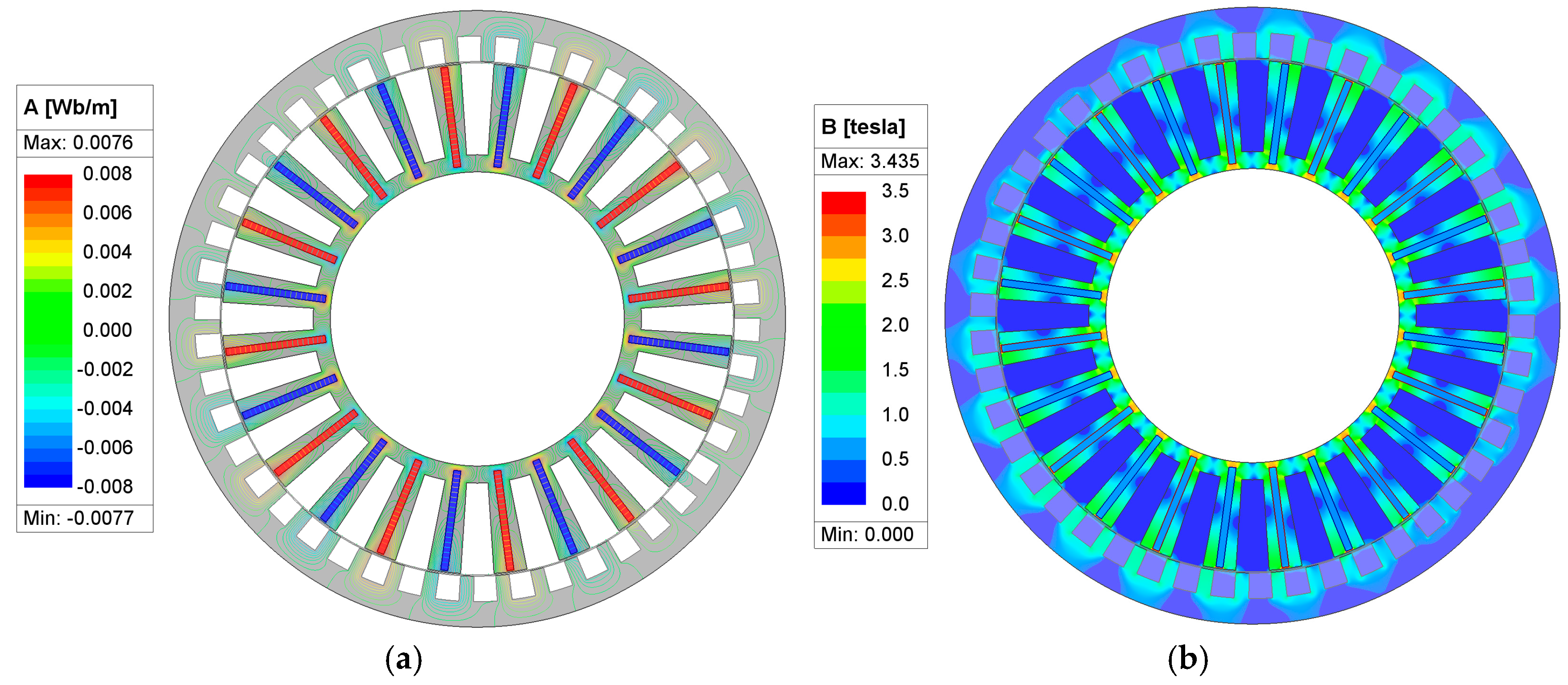

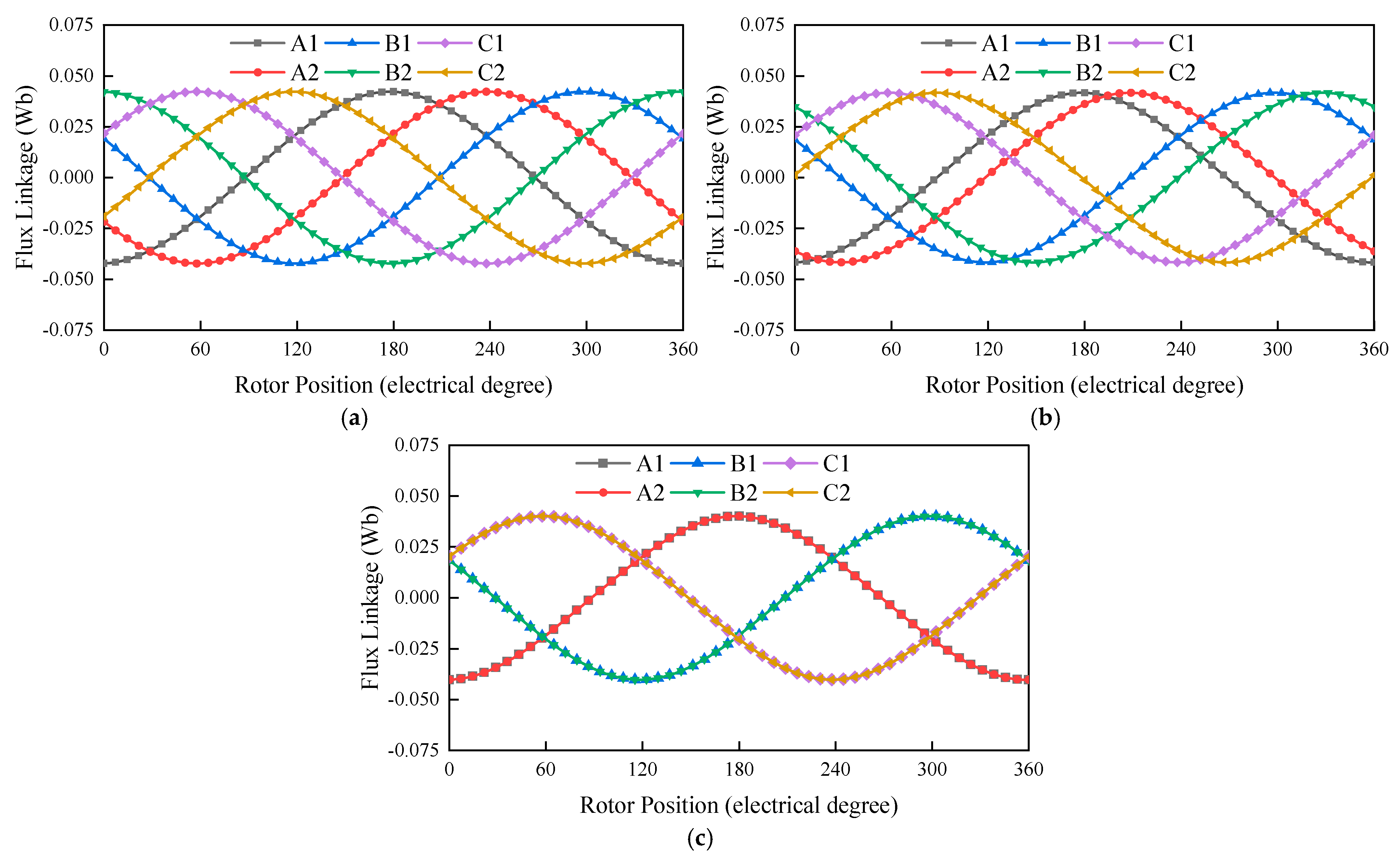


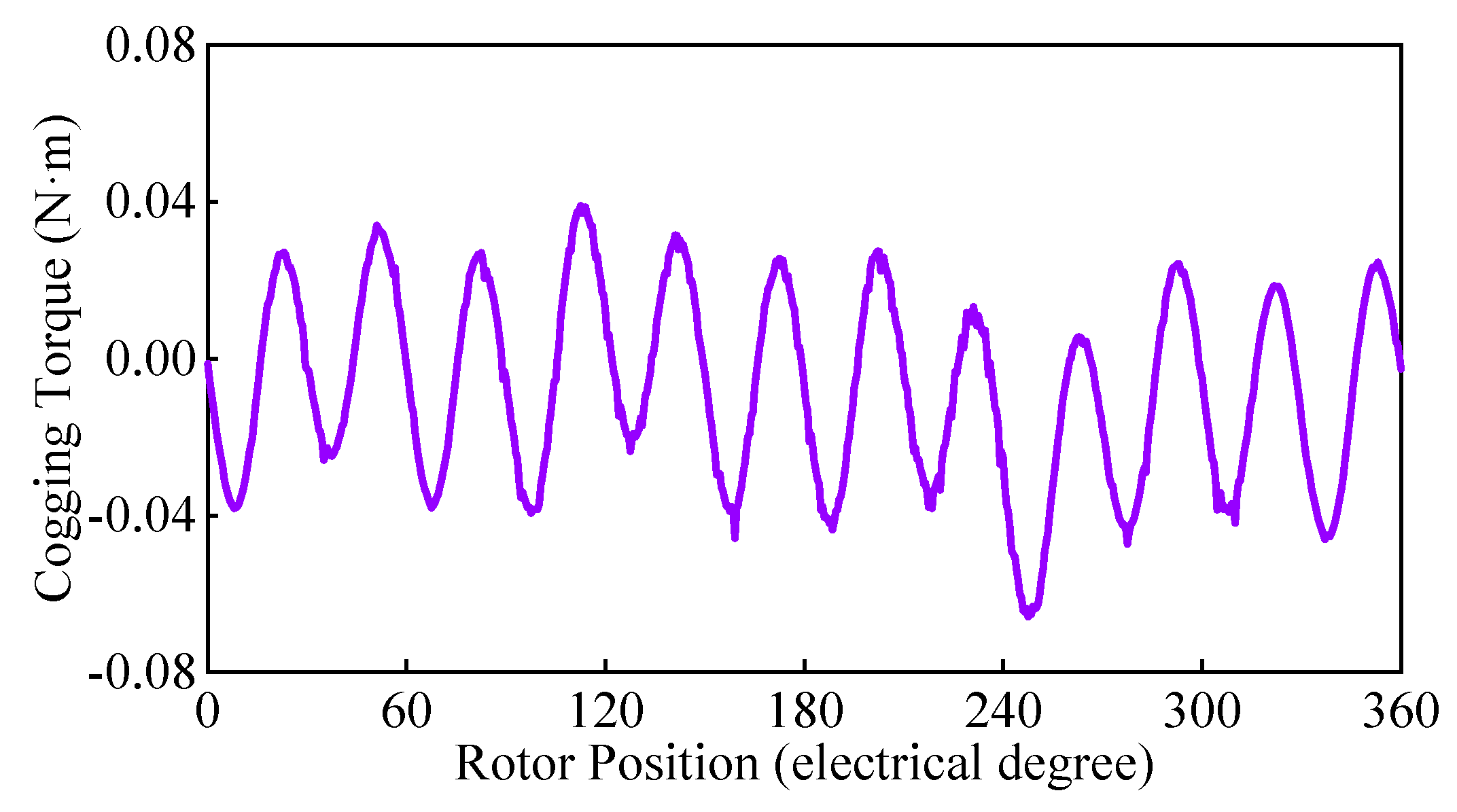
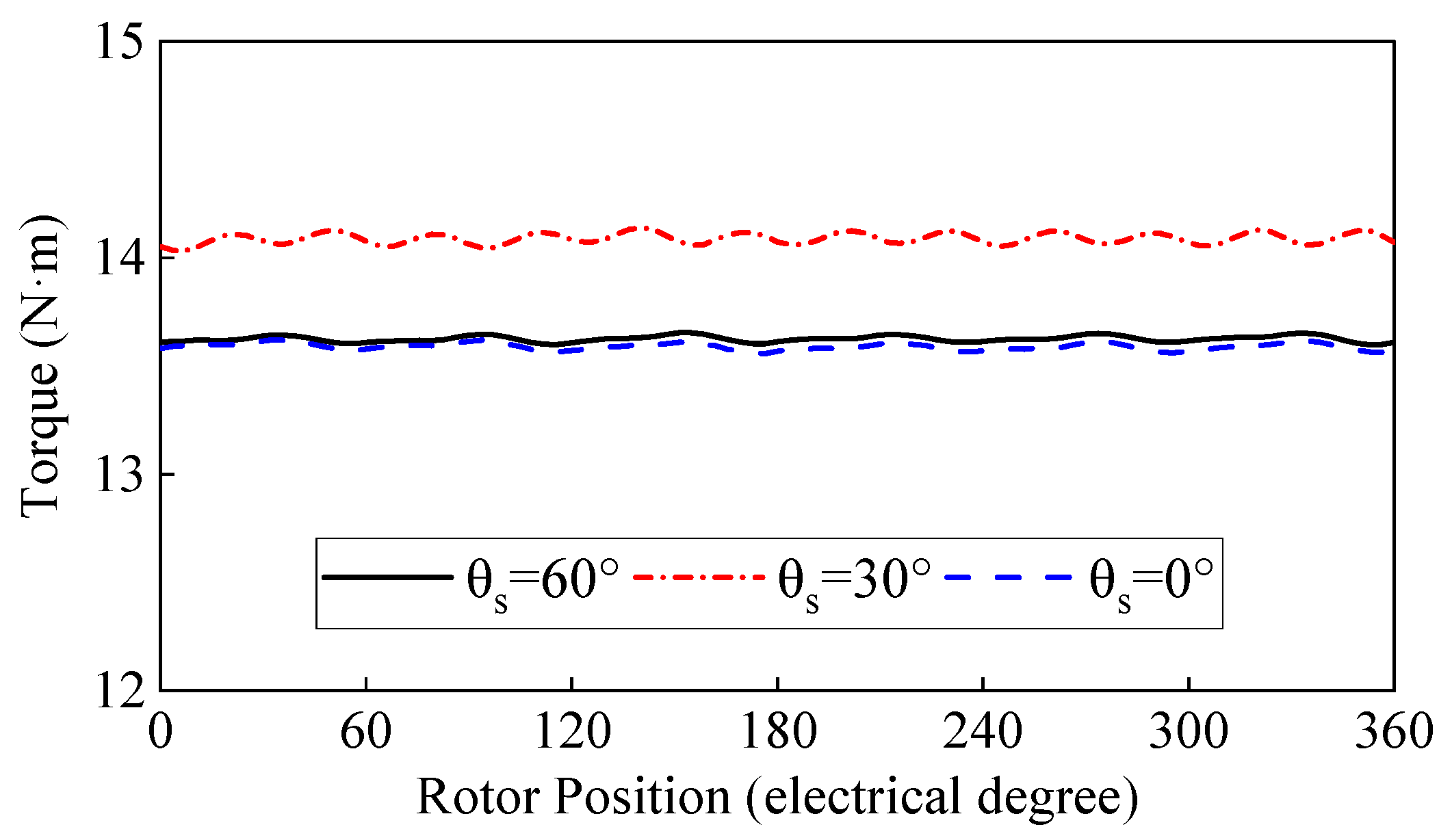
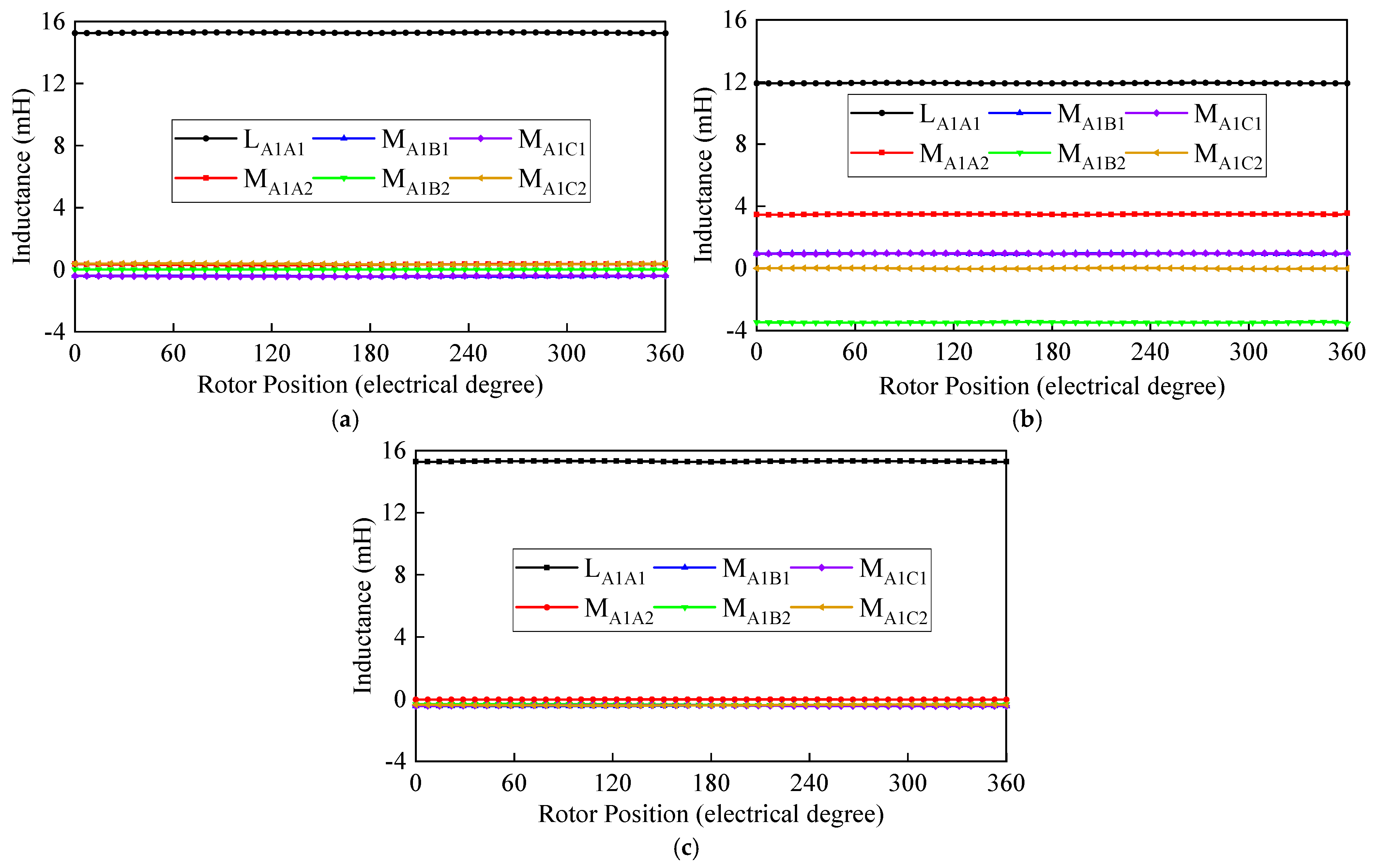
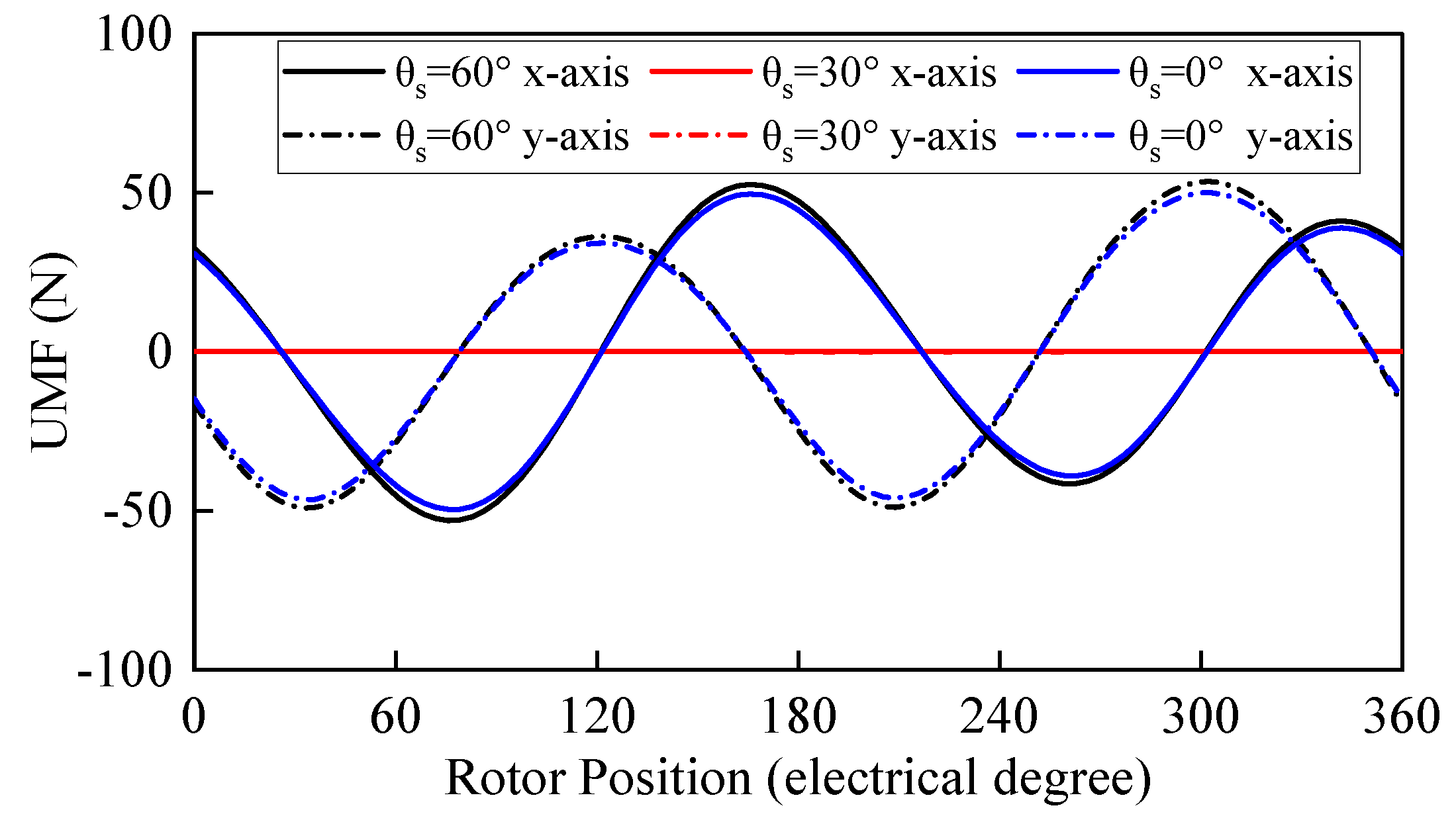


| Parameters | Unit | Value |
|---|---|---|
| Rotor Outer Diameter | mm | 206.5 |
| Air Gap Length | mm | 0.75 |
| Stator Outer Diameter | mm | 170 |
| Stator Inner Diameter | mm | 102 |
| Stack Length | mm | 100 |
| Rotor Pole Arc | degree | 3 |
| Rotor Pole Length | mm | 8.5 |
| Stator Pole Arc | degree | 2.75 |
| Stator Slot Arc | degree | 7.5 |
| Inner Iron Bridge Thickness | mm | 2 |
| Outer Iron Bridge Thickness | mm | 0.5 |
| PM Length | mm | 34 |
| PM Arc | degree | 2 |
| Number of Turns per Coil | - | 55 |
| PM Material | - | N40SH |
| Lamination Type | - | 20W1500 |
| Item | θs = 60° | θs = 30° | θs = 0° |
|---|---|---|---|
| kd | 0.966 | 1 | 0.966 |
| kp | 0.966 | 0.966 | 0.966 |
| kω | 0.933 | 0.966 | 0.933 |
| Inductance (mH) θs = 60° | Inductance (mH) θs = 30° | Inductance (mH) θs = 0° | |
|---|---|---|---|
| LA1A1 | 15.28 | 11.93 | 15.31 |
| MA1B1 | −0.41 | 0.96 | −0.41 |
| MA1C1 | −0.41 | 0.96 | −0.41 |
| MA1A2 | 0.39 | 3.48 | −0.02 |
| MA1B2 | 0.02 | −3.48 | −0.34 |
| MA1C2 | 0.37 | 0 | −0.37 |
| PH-Angle | Method | Amplitude of Phase Back-EMF (V) | Average Rectified Voltage (V) |
|---|---|---|---|
| θs = 60° | Measured | 31.5 | 62.9 |
| FEA | 36.7 | 70.1 | |
| θs = 30° | Measured | 33.5 | 62.4 |
| FEA | 37.5 | 69.2 | |
| θs = 0° | Measured | 32 | 55.6 |
| FEA | 36.7 | 60.1 |
Disclaimer/Publisher’s Note: The statements, opinions and data contained in all publications are solely those of the individual author(s) and contributor(s) and not of MDPI and/or the editor(s). MDPI and/or the editor(s) disclaim responsibility for any injury to people or property resulting from any ideas, methods, instructions or products referred to in the content. |
© 2025 by the authors. Licensee MDPI, Basel, Switzerland. This article is an open access article distributed under the terms and conditions of the Creative Commons Attribution (CC BY) license (https://creativecommons.org/licenses/by/4.0/).
Share and Cite
Huang, M.; Peng, A.; Zhao, L. Analysis of Different Winding Configuration on Electromagnetic Performance of Novel Dual Three-Phase Outer-Rotor Flux-Switching Permanent Magnet Machine for Oscillating Water Column Wave Energy Generation. Energies 2025, 18, 1021. https://doi.org/10.3390/en18051021
Huang M, Peng A, Zhao L. Analysis of Different Winding Configuration on Electromagnetic Performance of Novel Dual Three-Phase Outer-Rotor Flux-Switching Permanent Magnet Machine for Oscillating Water Column Wave Energy Generation. Energies. 2025; 18(5):1021. https://doi.org/10.3390/en18051021
Chicago/Turabian StyleHuang, Mingye, Aiwu Peng, and Lingzhi Zhao. 2025. "Analysis of Different Winding Configuration on Electromagnetic Performance of Novel Dual Three-Phase Outer-Rotor Flux-Switching Permanent Magnet Machine for Oscillating Water Column Wave Energy Generation" Energies 18, no. 5: 1021. https://doi.org/10.3390/en18051021
APA StyleHuang, M., Peng, A., & Zhao, L. (2025). Analysis of Different Winding Configuration on Electromagnetic Performance of Novel Dual Three-Phase Outer-Rotor Flux-Switching Permanent Magnet Machine for Oscillating Water Column Wave Energy Generation. Energies, 18(5), 1021. https://doi.org/10.3390/en18051021






